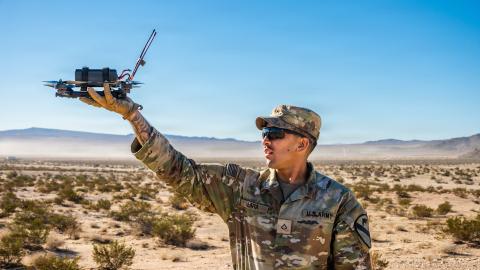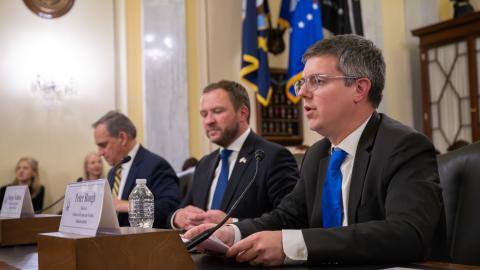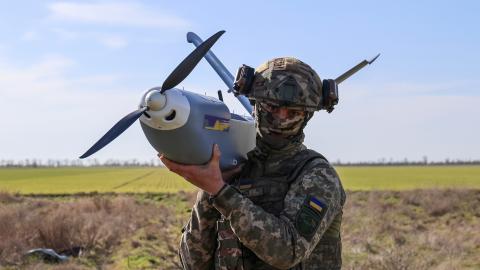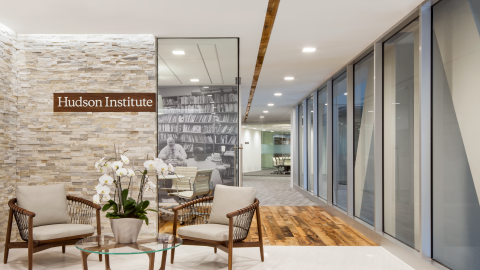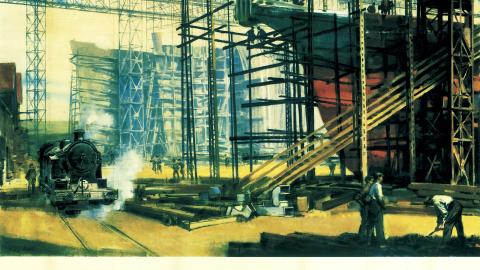Commercial shipbuilding in America is on the path to extinction, unless big changes get underway. The loss of America’s shipbuilding industry would do irreversible damage both to the future of the U.S. Navy and to six decades of American naval dominance.
In our last entry, we looked at ways that Henry Kaiser, the master shipbuilder of the Second World War, can show us how to reverse maritime shrinkage and decline.
Between 1941 and 1944, Henry Kaiser surged ship production in ways that had never been imagined. Working with a single, simple ship design, he and his colleagues produced over 2,710 of the so-called Liberty ships. All were built at ten yards that didn’t even exist when Kaiser got his first contract in December 1940. Following that success, Kaiser built aircraft carriers, so-called baby flattops of the Casablanca class, that enabled the Navy to close the vast strategic depth of the war in the Pacific—the same region where a naval war with China might break out in the near future.
In Part I, I drew out three important lessons from Kaiser’s legacy that should guide anyone looking to surge our merchant marine and rebuild our naval supremacy in relation to China.
The first was, stop thinking like you are building ships. Kaiser rethought the entire process, from the keel up and from stem to stern.
The second was, rethink processes and materials. In Kaiser’s case, that included not only substituting what was available for what wasn’t (for example, reciprocating engines instead of turbine or diesel) but also creating his own supply source for steel, with the state-of-the-art mill he built in Fontana, CA.
The third was, stop worrying about workforce, just hire and train whoever is willing to show up. Kaiser and his colleague Steve Bechtel, CEO of Bechtel Engineering, firmly believed workforce issues should be treated as an opportunity, not an obstacle. When Bechtel opened his own Liberty shipyard in Marin County, CA in 1942, America’s defense industrial base was already scraping the bottom of the workforce barrel.
Bechtel, like Kaiser, had to draw his team with better wages and the promise of a job that would last at least until the war’s end. At the Marin yards his supervisor staff included a former orchestra leader, a nightclub proprietor, and an ex-cabinetmaker. Some of his draftsmen had never drawn a ship. Many of the line workers were disabled. Today, with AI able to provide on-the-job training and software support, workforce shortages look a lot less daunting than they did in 1942.
With those three lessons from Henry Kaiser in mind, here are two more.
Act like you are in a race, because you are.
Kaiser learned from his dam-building days the importance of promoting competition among work teams to see who could build fast and safe. This was important not only to get a job done ahead of schedule, but also to break through to the next level, where “fast and safe” becomes the fastest and safest. In short, competition breeds innovation as well as productivity.
During World War II, Kaiser embedded this competitive principle into the basic ontology of the Liberty ship program. He did whatever he could to pit his son Edgar, in charge of the shipyards in Portland, against the man who ran the Richmond, CA yards, Clay Bedford, to see who could build a Liberty ship in the shortest possible time.
The result was an epic explosion of shipbuilding, as the workforces at both yards got caught up in the competitive spirit.
Edgar’s tenth ship at Portland, the Robert Fulton, took 154 days to build. By April, the number had been cut to 86 days; by July, Hull No. 230 was done in just 43 days—breaking the fifty-day goal Clay Bedford had set for his team in Richmond. Then, on September 23, Edgar’s team finished the Joseph Teal in just ten days.
That week, workers arriving at Richmond Yard No. 2 found a flyer in the company newsletter that read, “What’s Oregon Got That We Haven’t Got?”
The flyer set the work crews at No. 2 aflame. Bedford received 250 letters from his workers, suggesting ways to speed up the construction process, as he and his supervisors made plans to build the next Liberty ship in half the Portland record, i.e. in five days.
Starting at midnight on Sunday, November 8, in front of a huge crowd and the media, Bedford and his team did exactly that. At 3:27 p.m. on November 12, the Robert E. Peary was launched, while telegrams of congratulations poured in from across the country. For Bedford, however, the most meaningful message was from Edgar Kaiser, which included a postscript: “Now, if we cut your record in half, what will you do?”
In fact, Bedford’s record stood for the rest of the war as a supreme industrial engineering feat. But that November the benchmark pace of production had been set. That month Richmond No. 1 and 2 together averaged one new Liberty ship every other day; by 1944 American yards were launching 50 merchant ships a day.
We don’t need a motivational genius like Henry Kaiser to gin up a shipbuilding competition. We already have one, with China. And the awarding of contracts shouldn’t be based just on monetary cost, but on time cost—how fast can you help us close the gap with China?
That brings us to our final lesson:
Treat the Navy as just another customer.
That’s what Henry Kaiser did when he learned that the Navy needed smaller, faster aircraft carriers—and lots of them—for rapidly expanding operations in the Pacific. The Navy also wanted an original design that could be built in one-quarter of the time of its smallest existing carrier, the Independence class.
Kaiser immediately turned to an experienced designer to come up with a ship that was smaller but that also had more deck space than the Independence class. And since there were no diesel or turbine engines available anywhere for a new class of naval vessel, Kaiser switched over to a five-cylinder reciprocating steam engine—another example of rethinking design based on the materials at hand, not what a designer (or customer) might dream about.
That included the navy. Although Kaiser said he could switch all the Portland yards to make the new “baby flattops,” as they would be called, and would have 50 carriers finished six months into production, the Navy balked. The plan was too unconventional—and Kaiser too unconventional a contractor—for the Navy to accept his bid.
Undeterred, Kaiser approached someone who could show his design to President Roosevelt himself. For FDR, Kaiser could do no wrong. The man who had revolutionized merchant shipbuilding looked like just the man to change how the Navy made ships. Roosevelt overruled Admiral Ernest King, and on April 5, 1943, First Lady Eleanor Roosevelt was in Portland to christen the first of Kaiser’s baby flattops, USS Alazon Bay. The Navy got its 50 Kaiser carriers before the war ended; in fact, by 1944 it was getting eight aircraft carriers a month, thanks in large part to Henry Kaiser, his unconventional design, and his belief he could find a way to build a better product for the Navy, just as he did for all his other customers.
A last thought. Looking at the enormous shipbuilding gap we have today with China can be daunting. One estimate states that China’s yards can produce more than 200 times more ships than our own. But in light of Henry Kaiser’s achievements, maybe changing the dynamic won’t be as slow and complex a process as we’ve been conditioned to think.
Palantir’s Bill Rivers suggested one possible answer in the very first issue of The Republic: we could unleash America’s billionaires to build fleets of unmanned vessels, just as they’ve built fleets of rockets for commercial and military space launch.
Another might be to look at a simple technology that transformed world maritime shipping starting in the 1950s: the cargo container. With one straightforward, modular design by Malcolm McLean—a man who was not in the shipping business but the trucking business—the standard cargo container slashed ship loading times while expanding the size of ships, trucks, trains, docks, and ports. At the same time, labor costs tumbled and theft was reduced, thanks to the closed and locked containers.
The answer to closing the shipbuilding gap may not be as straightforward, but it will probably come from someone far outside the conventional shipbuilding community who loves solving problems—someone like McLean or Kaiser.
It was Kaiser’s great joy to be part of arming America in World War II. In fact, when Kaiser took over the Buffalo aircraft works in November 1943, he felt so elated he actually burst into song. Before an astonished audience of 7,000 plant workers, politicians, and journalists, he sang the opening lines from the hit musical Oklahoma!: “Oh, what a beautiful mornin’!”
I don’t know anyone who thinks we are on the verge of a beautiful morning for our shipbuilding industry. But perhaps we can at least find someone who can confront our problems not with despair or even grim determination but—as Kaiser did—with a sense of expectation and joy.
